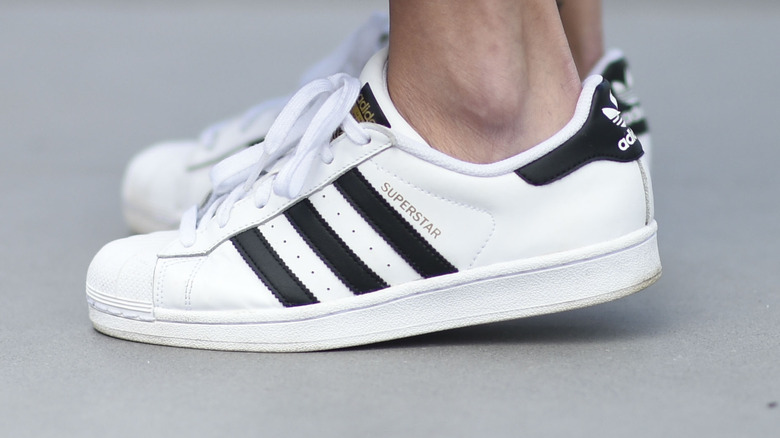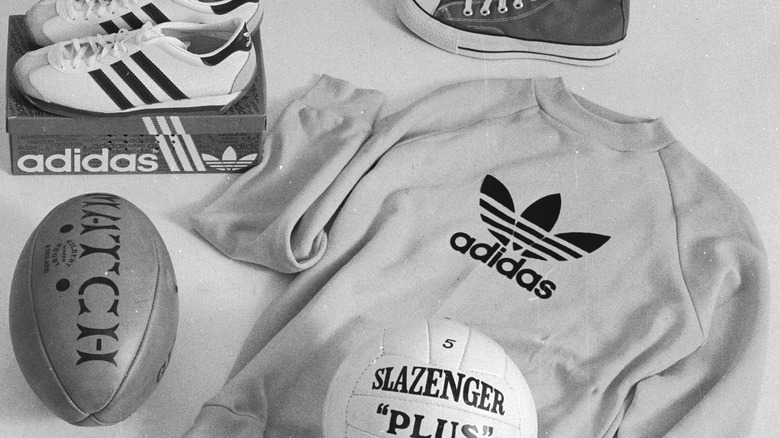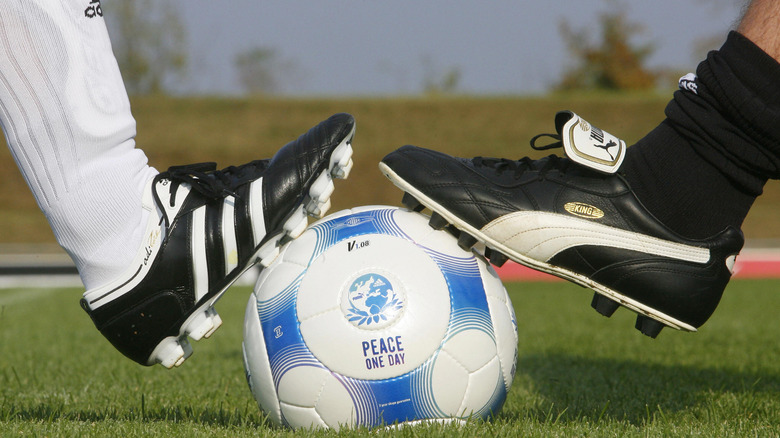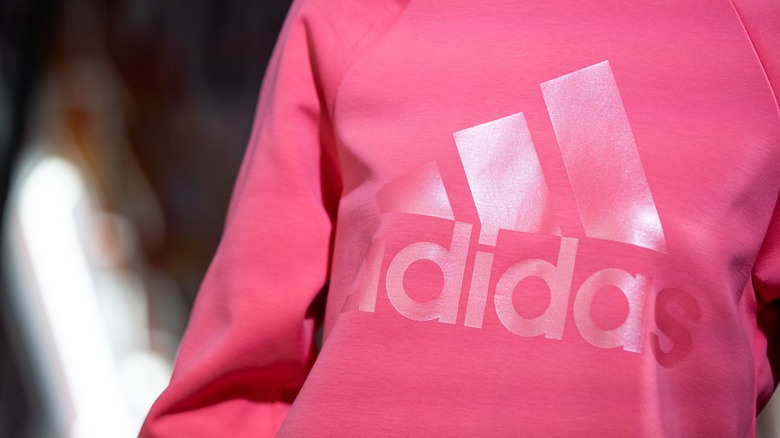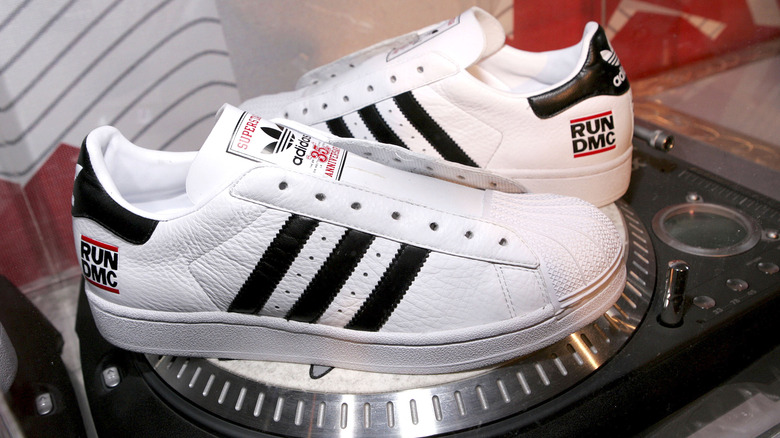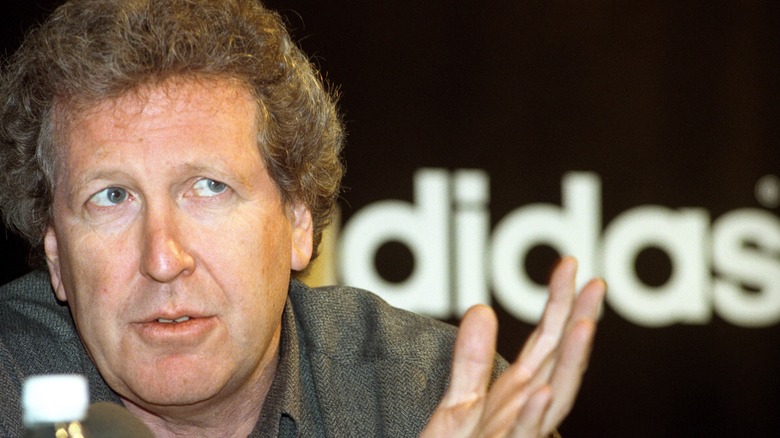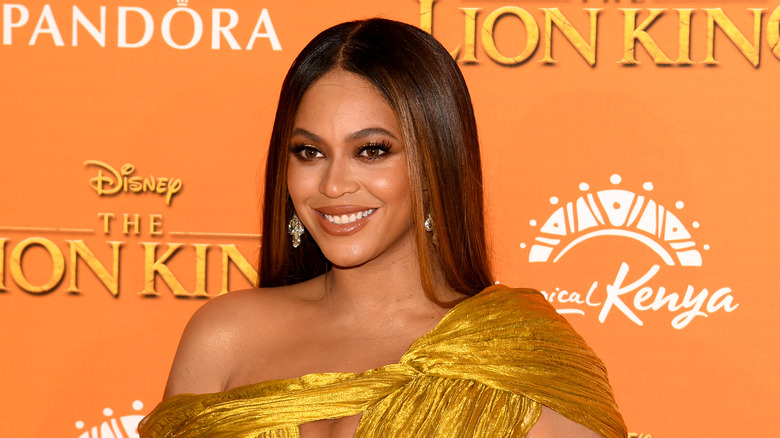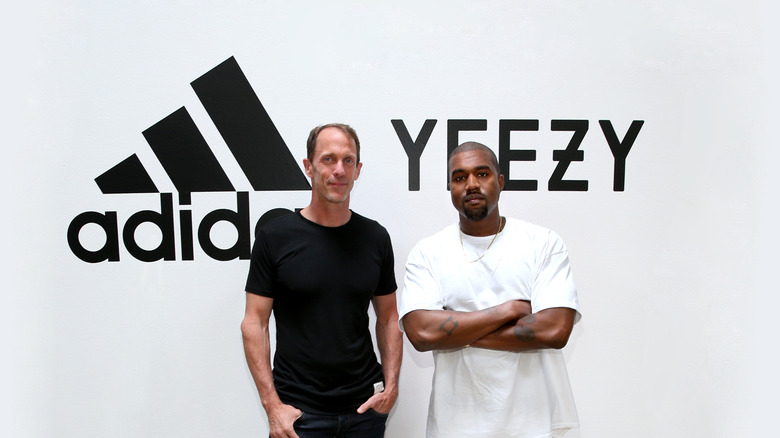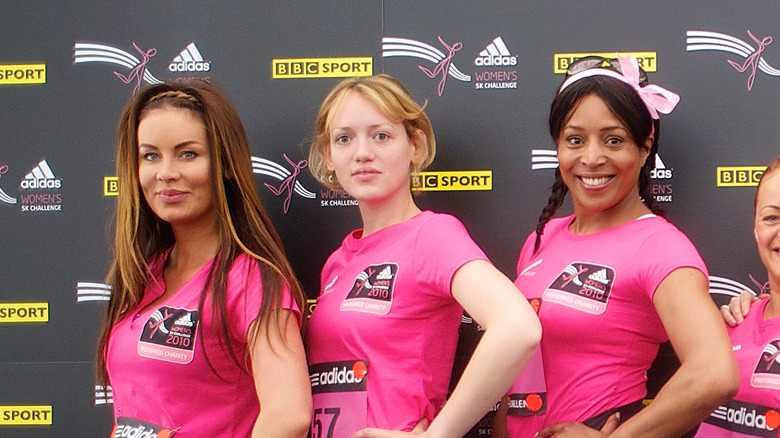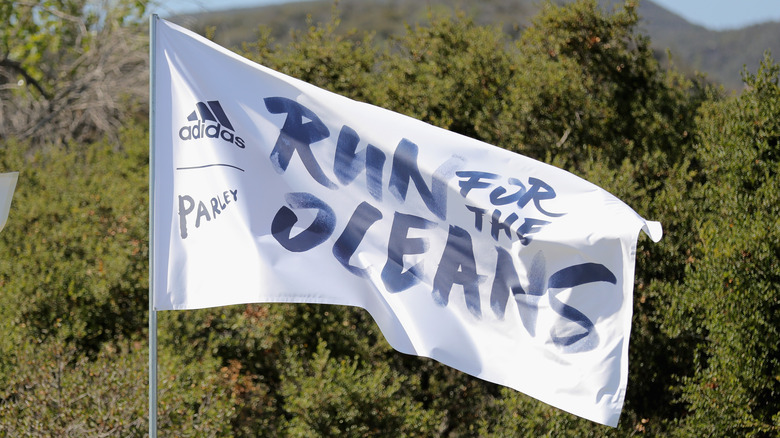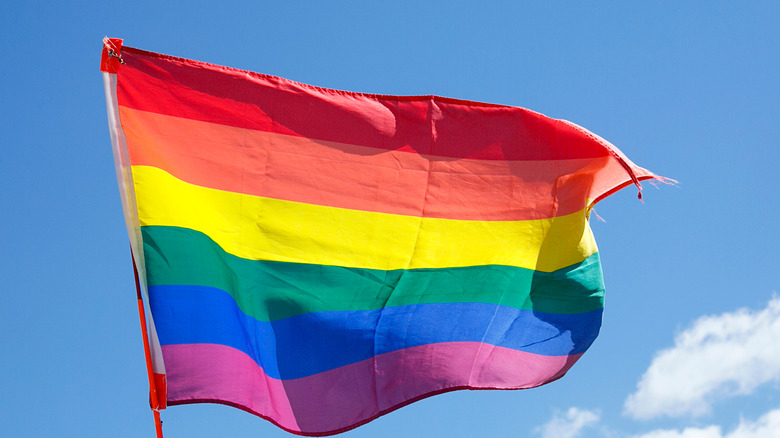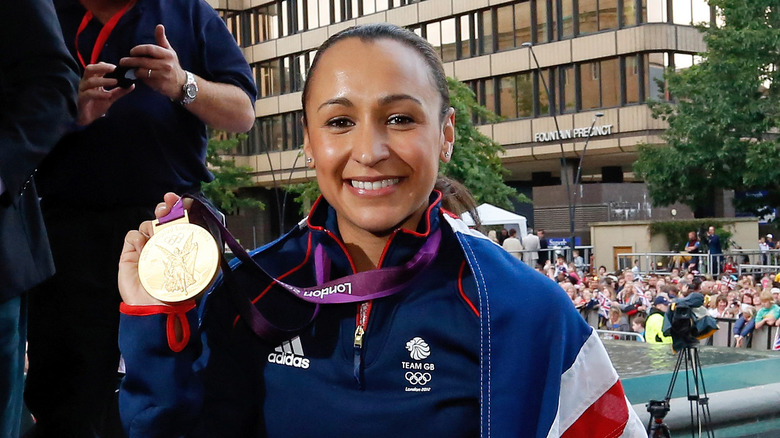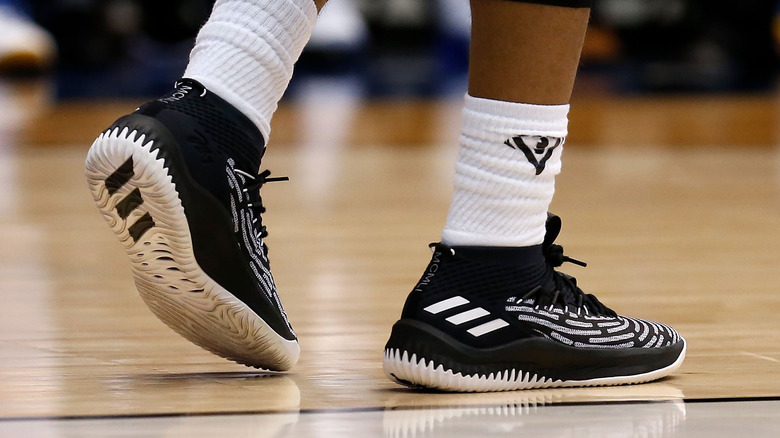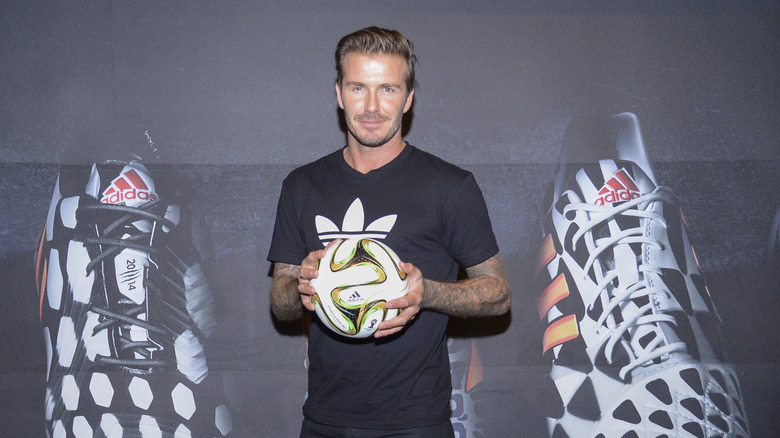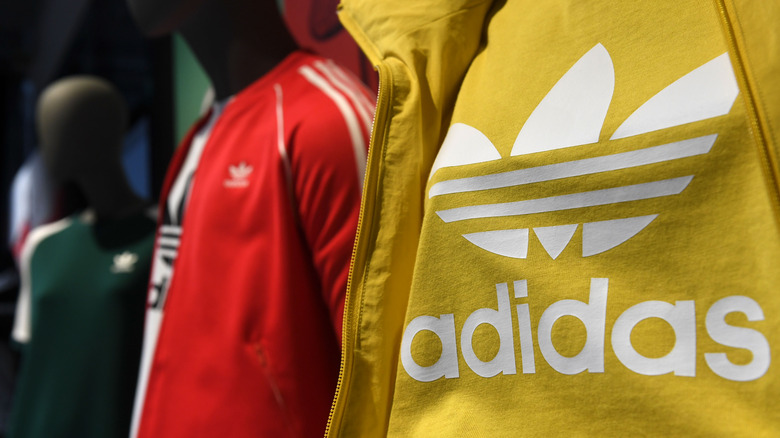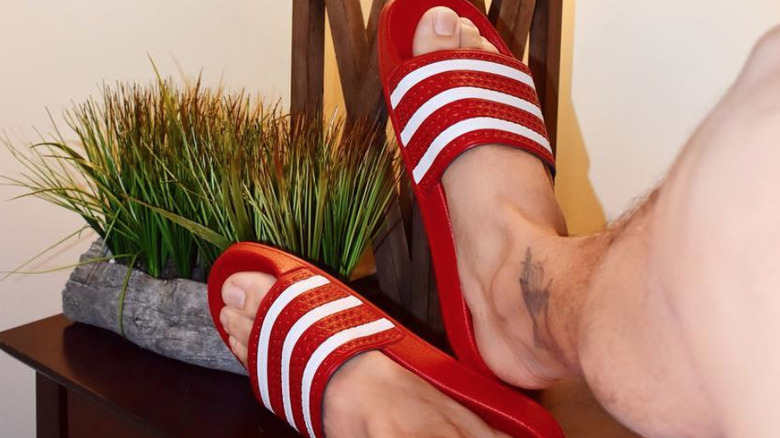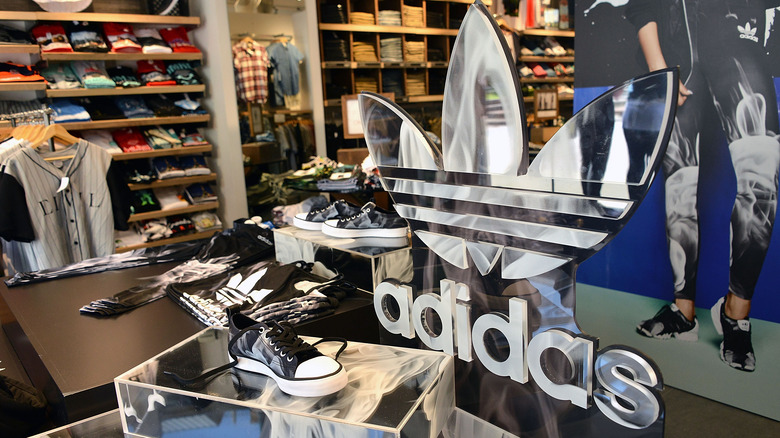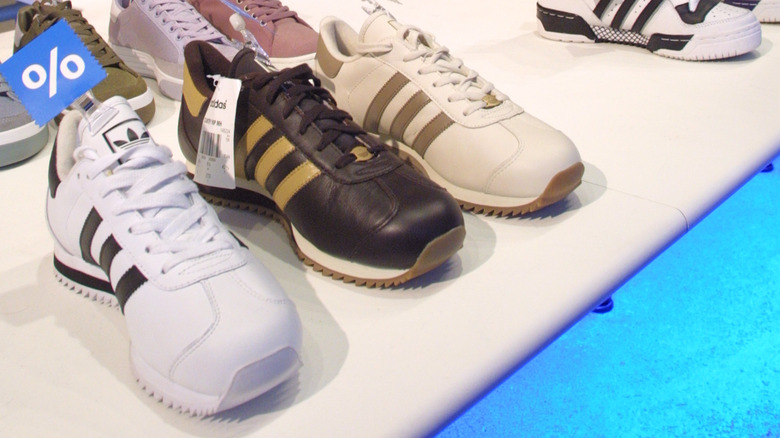Don't Spend Money On Adidas Until You Read This
For 70 years, the name Adidas has been synonymous with the world of sports. Currently valued at a staggering $16.7 billion, the company comes in second behind Nike in terms of the biggest sportswear brands. Headquartered in Herzogenaurach, Germany, Adidas currently employs over 57,000 people, according to Adidas' website. In 2018, Adidas Group produced over 900 million units of sportswear and other products. As noted by the brand's self-published 2013 mission statement, "The Adidas Group strives to be the global leader in the sporting goods industry with brands built on a passion for sports and a sporting lifestyle."
Though wildly popular and successful now, the brand has certainly suffered the wax and wane of prosperity over the years and has been the center of controversy many times. Whether you've been thinking about investing in some Adidas sportswear for the first time or you're thinking about adding another pair of kicks to your wardrobe, it's best to know more about the brand you may spend your hard-earned cash on. Here's what you need to know about the behemoth sports brand.
The unusual history behind Adidas
For savvy shoppers, it is important to know the history of a brand, especially if it involves, well, Nazis. Adolf Dassler was born and raised in Herzogenaurach, Bavaria, according to a timeline on his memorial foundation website. He expressed an early interest in athletics and shoemaking, which wasn't too surprising as his hometown was a well-known haven for shoemakers, as noted by Spiegel Online. After serving in World War I, he produced his first sports shoe in his mother's washroom. Joining forces with brother Rudolph, they formed Dassler Brothers Shoe Manufacturers. Together, they began producing soccer and running shoes. They made a name for themselves in the 1936 Olympics when track star Jesse Owens nabbed four gold medals while donning their spiked track shoes.
As they garnered international attention, World War II began, and, like many businesses, their company changed operations in support of the war. Both brothers joined the Nazi party in 1933, according to Spiegel Online. At the end of the war, the Americans occupied Germany, and the brothers began producing basketball, baseball, and hockey footwear for American soldiers. They continued operating the business until 1948, when the brothers had a major falling out.
A sibling rivalry caused Adidas to form
According to the company's mission statement, Adidas strives to outpace its competition. If you've been thinking about purchasing a pair of kicks from the brand, it is good to know that competition has certainly been a key factor in the company since its inception. In 1948, brothers Adolph and Rudolph Dassler split due to "irreconcilable estrangement."
Their fight was rumored to begin during World War II and was possibly due to "wartime records," according to CNBC Meets. The brothers split the business, and each set off on their own with Rudolph forming Ruda, which would become Puma, and Adolph,who was nicknamed "Adi," forming Adidas. The repercussions of their separation had a lasting global effect and split their town in two. In her book Pitch Invasion (via CNBC Meets), Barbara Smit explained that the town took on the nickname of "the town of bent necks" because everyone would look to see what brand of shoe people wore.
Given that the brothers reportedly never spoke again, clearly Adidas has always been about crushing the competition.
What Adidas' logos really mean
Adidas' über-famous three-striped logos are instantly recognizable to millions of people around the world, but it is helpful to know the meanings behind each. The main logo originally belonged to Finnish shoe brand, Karhu, but was rumored to have been acquired by Adi Dassler in exchange a couple of bottles of whiskey and around 1600 euros, according to Karhu's website.
In 1972, Adidas rolled out the "Trefoil" logo, which continues to appear on apparel and shoes today. Supposedly, the three leaves are meant to represent the three land masses of the Americas, Europe and Africa, and Asia. In the late '90s, Adidas added yet another option in the form of the "three bars" logo. This time, the three stripes in the Adidas logo were rumored to be arranged to resemble a mountain range to signify the challenges of athleticism and "the goals to be achieved."
Adidas is for music lovers
In 1986, Run DMC released their massive hit "My Adidas," and, since then, a decades-long relationship with music has prevailed. Early on, the brand took notice and began investing in artists beginning with a $1 million contract with Run DMC. It is rumored to be the very first brand sponsorship in the realm of rap. The Beastie Boys followed suit, sporting mostly Adidas for years. From Stan Smiths to the Campus shoes, kicks of all Adidas collections have been amplified by their association with music. And it wasn't just hip hop. Artists like Oasis and Gwen Stefani frequently don the brand.
It looks like the company's investment in and attention to music isn't going anywhere anytime soon. In a Forbes interview, Adidas Originals general manager Torben Schumacher said, "Music is the heartbeat of culture that unites audiences in an organic way. While partnerships have grown in recent years, we continue to have two-way conversations with talent." It's obvious these conversations are going pretty well, as evidenced by the wildly successful partnerships that are popping up all the time like ones with Pusha T, Pharrell, Kanye West, and Rita Ora.
Seinfeld fans, take note of this connection to Adidas
While Adidas is second in the world of athletic shoes only to Nike now (via Brand Finance), it has definitely been subject to economic downturns. According to The New York Times, after Adolf Dassler's death in 1978, the company had fallen significantly behind both Reebok and Nike and was in need of a turnaround. And that it got thanks to one man with a surprising connection to Seinfeld: Robert Louis-Dreyfus, cousin of famed Seinfeld star Julia Louis-Dreyfus.
Nicknamed the "Turnaround Specialist," Robert came from a successful grain and shipping family and had a background in helping flailing businesses regain their footing and turn big profits. With Adidas, he employed techniques such as cutting payroll, decreasing marketing budgets, and outsourcing production to Asia. In Adidas' statement upon his passing in 2009, the company said he took over in 1993, navigated the IPO process in 1995, and began acquiring other companies like TaylorMade and Salomon in 1997.
Save your money for Beyonce's Adidas collaboration
On April 4, 2019, Beyoncé and Adidas announced a "multilayered" partnership that will include creative direction from Bey, as well as new apparel and footwear (via People). Later that month, Beyoncé posted an epic Instagram video, revealing that her brand Ivy Park would be joining forces with the sportswear giant. Showing Beyoncé walking on a stage lined with the iconic three stripes, the announcement hit following the release of her documentary Homecoming on Netflix.
While Beyoncé's athletic and leisure brand Ivy Park was initially launched with TopShop as a partner, allegations of misconduct against the owner came out in October of 2018. Wasting no time, Beyoncé bought out TopShop's ownership in November of the same year (via Vogue), paving the way for her exciting partnership with Adidas. At the time of this writing, the landing page for Ivy Park states, "Beyoncé and adidas are natural partners, both with a deep respect for and commitment to creativity, equity and creators."
Don't forget about Adidas' collaboration with Kanye West
In late 2013, an Adidas spokesperson confirmed to Wall Street Journal that the brand was welcoming Kanye West "to the Adidas family," calling him "one of the most influential artists of this generation." No one yet knew just how wildly successful the partnership between Adidas and Kanye West was to become. Since then, the collaboration has influenced the entire industry (despite some questionable behavior on behalf of the star).
A GQ article on the evolution of the brand said, "When Adidas executives talked about Yeezy, they espoused its halo effect, not its volume." When Yeezys hit in 2015 at $200 a pair, the shoes flew off the shelves and became an instant hit. As noted by GQ, the brand has pivoted from the scarcity tactic they formerly employed and are selling higher volume while still maintaining a high price. For instance, in a June 2019 Adidas post, the company said that the Yeezy Boost 350 v2 Lundmark RF would launch on July 11, 2019, with a whopping $220 price tag.
Adidas is a big supporter of women in sports
If inclusion and gender parity is important to you, look no further than Adidas. In 2018, the brand launched a new initiative called She Breaks Barriers with the premiere of a film by the same name that highlights barriers that women face in the sports world. Regarding this movement, the brand said, "This multi-faceted initiative is designed to inspire, enable and support the next generation of female athletes, creators and leaders."
It was released in tandem with an open letter to Adidas employees and communities across the globe. Citing studies that highlighted women's lack of access to sports and the low retention rates of women in sports, the brand laid out its plans for trying to effect change for higher rates of participation and inclusiveness. Some of these initiatives have included partnering with think tanks, sponsoring the Women's National Football Conference, engaging in dialogue in communities and on college campuses, and partnering with Girls on the Run.
Sustainability is a top priority for the brand
Many shoppers want to know about brands' sustainability initiatives. Adidas takes the topic very seriously and has made much progress when it comes to accountability to the planet. Three main arenas of the brand's 2020 sustainability priorities are "We Value Water," "We Innovate Materials and Processes," and "We Conserve Energy." Some of the plans include expanding waterless technologies, cutting down on water usage during production, obtaining LEED certification for new buildings, and significantly reducing the use of virgin plastic in Adidas products.
According to Outside, a publication that references Adidas as a "global leader" on the sustainability front, "What makes Adidas's efforts even more impressive is its overarching belief that making quality products is just as important as reducing waste and employing recycled materials."
Forbes detailed a limited edition Adidas shoe released in 2018 that was made up of the "equivalent of eleven plastic bottles worth of waste." They sold out immediately, and Adidas plans on selling 5 million more pairs at $220 each, so the company will be making bank while cleaning up the oceans.
Adidas places a high importance on human rights
Adidas is serious about human rights. Policies, standards, and FAQ regarding employees, as well as contracted laborers and manufacturing partner employees, are easily accessible. The brand states that it has a "winning culture" and there are three key behaviors they employ to achieve this: confidence, collaboration, and creativity, or, as the Adidas "culture" page on their website calls it, "the 3Cs." The brand also stated that it places a lot of importance in the realm of leadership, believing that they "need to have great leaders in our company that constantly develop and inspire their teams and serve as role models for the leaders of the future."
The British charity, Corporate Human Rights Benchmark (CHRB), found that Adidas came out on top in terms of human rights policy and practices, scoring 87 out of a possible 100 points. However, there are reports of factory worker mistreatment by the brand in recent years.
Adidas also places great importance on standing with and supporting the LGBTQ+ community. With the "Love Unites" campaign in 2019, the brand released rainbow sportswear and made a significant financial donation to The Trevor Project in honor of Pride month.
Adidas' long history at the Olympics
If you are an Olympics fan, you'll be pleased to know that Adidas is nearly synonymous with the games. Beginning in 1928, Adidas began a strong relationship with the Olympics when Adolf Dassler introduced his spiked running shoe called the "Waitzer." In the 1932 Olympics, a runner in Dassler Brothers shoes won a bronze medal. But it was in 1936, when American runner Jesse Owens took home four gold medals at the Berlin Olympics that the relationship really took hold. This was huge international news as Adolf Hitler was intending to use those games to showcase his "ideology of Aryan racial supremacy," according to History.com, and instead the headlines covered a lightning-fast African-American man donning a German-made shoe.
The international notoriety set the stage for the successful launch of Adidas after World War II. Runners from all over began wearing Adidas for Olympic races, and, over the years, the brand began adding new sports to the footwear and clothing roster, including weightlifting, tennis, and boxing shoes. Throughout the years, countless athletes wearing Adidas gear have taken home medals, such as gymnast Nadia Comaneci, tennis maven Stefi Graf, and track star Wilma Rudolph.
What you should know about Adidas' alleged link to a college basketball scheme
It is always helpful to know about scandals surrounding a company if you are considering spending hard-earned cash. While Adidas is known for its support of athletes in nearly every sport imaginable and has given opportunities and changed the lives of many for the better, it seems that occasionally the practice goes too far.
In October of 2018, two former Adidas employees were convicted of wire fraud and conspiracy to commit wire fraud in a case regarding illegal recruiting practices in the world of college basketball. According to ESPN, "They were accused of funneling money from Adidas to the families of high-profile recruits to ensure they signed with the sneaker company ... once the players turned pro." The Adidas employees were allegedly looking to sign them to official Adidas-sponsored teams after the students graduated. Under NCAA rules, players and players' families cannot be compensated for their athletic ability, so that likely led some sports companies and professional teams to create systems that operate in a "gray" area in order to lure recruits.
Nothing goes better together than Adidas and soccer
Soccer — or football, as it's known everywhere outside of the U.S. — is undoubtedly the most popular sport in the world. Four out of ten people on the planet claim that they are big fans of the game. If you are one of those folks, you'll be happy to know that Adidas invested early in the sport. There are even theories that claim the name of the brand is an acronym for "All Day I Dream About Soccer." While this is patently false, the sentiment rings true for Adidas.
According to The Irish Times, Adolf Dassler designed a new kind of soccer boot for the West German team in 1953, and the shoes debuted at the 1954 World Cup. This secured Adidas a prominent place in soccer moving forward.
For over 40 years, Adidas has been the supplier of official World Cup balls for FIFA, and, for the past few decades, has been official partners of FIFA World Cup. The brand is also now spending big with Major League Soccer in the U.S., and has had partnerships with soccer superstars like David Beckham.
Your Adidas purchases may help fund charity work
In addition to their work with Girls on the Run and The Trevor Project, Adidas places a high priority on charitable actions. According to the company's website, Adidas strives to make positive impacts in regions around the world where they have presence by leaning on representatives in those communities to identify needs and local partners.
The company employs creative methods to raise funds like the sale of specific products for certain issues. The brand designed a shirt to fundraise for Southern California schools and rebuilding efforts in Haiti. Adidas is also an official partner of the nonprofit Soles4Souls, which has donated over 35 million pairs of shoes in 127 different countries around the world. Additionally, Adidas is known to provide disaster aid relief, such as in the wake of Hurricanes Harvey, Irma, and Maria.
Adidas also works to aid refugees. According to the company site, they offer internships and "tuition for language classes as well as intercultural communication, job application training and sports courses."
The power of the Adidas slide
Love them or hate them, the Adidas slide sandal has made a serious comeback as of late. Seen everywhere from the pool to gym showers to fashion magazines, Adidas slides launched a fashion movement largely by accident. Created out of a utilitarian need to keep bare feet from touching nasty locker room floors, Adidas designed its "Adilette slides" at the request of a German soccer team. Officially available to the masses starting in 1972, they were marketed as a pool shoe because of the ease of taking them on and off. While still capable of serving their original purpose of bacterial and fungal protection, the slides have found a place in pop culture with celebrities like Mark Zuckerberg and Katy Perry known to sport them regularly.
Now available in various styles, the original slides were made of rubber and plastic but are also now manufactured with a "cloudfoam" option. Base level models come in pretty cheap at $35 a pop.
Where to pick up Adidas products in person
While Adidas products can be purchased at most major shoe retailers and online, the brand has many of its own brick and mortar locations around the world, boasting a mix of traditional stores, pop-ups, outlets, and concept stores. Adidas' store locator on the brand's website can be used to find a store near you.
As of April 2019, there were officially Adidas stores in 35 states in the U.S. and in 19 total countries around the world. The flagship store for North America is located on Manhattan's 5th Avenue and features 45,000 square feet of retail space (via Business Insider). There, with the store's large size, customers have the option of customizing their shoes and viewing the wide array of products Adidas sells.
A 2017 report from China Daily detailed that the brand has plans to open 2,000 new stores in China by 2020 as business is booming in the country. China has become Adidas' second largest market behind Western Europe. The massive addition of stores would bring the grand total of Adidas locations to 12,000 stores in China alone.
Don't forget about Adidas' major sales and discounts
Adidas provides plenty of sales throughout the year. For instance, for July 4, 2019, the brand did a 30 percent off site-wide sale with few exceptions, and the 30 percent off discount covered items already on sale. Adidas also offers special discounts to members of Creators Club, a free promotional rewards program where customers can set preferences and get customized updates from the brand. It is super simple to sign up, and the program tracks your customer history. You can earn points for every Adidas purchase.
Additionally, Adidas' site offers 15 percent off for signing up for promotional emails to receive news and updates from the brand. Sites like Honey also track current discount code offerings and can help figure out if there are any sales going for the brand.
At times, Adidas also offers free shipping and returns on U.S. domestic purchases, so be sure to keep an eye out for great deals before making any purchases. But not everything goes on sale, so it's best to check out the FAQ regarding promotions, which is a helpful resource for all sale and free shipping-related questions.
